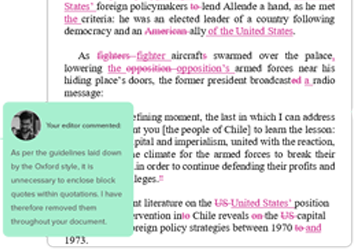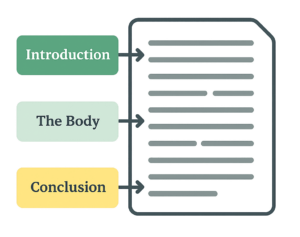- Tips to Self-Edit Your Dissertation
- Guide to Essay Editing: Methods, Tips, & Examples
- Journal Article Proofreading: Process, Cost, & Checklist
- The A–Z of Dissertation Editing: Standard Rates & Involved Steps
- Research Paper Editing | Guide to a Perfect Research Paper
- Dissertation Proofreading | Definition & Standard Rates
- Thesis Proofreading | Definition, Importance & Standard Pricing
- Research Paper Proofreading | Definition & Standard Rates
- Essay Proofreading | Options, Cost & Checklist
- Top 10 Paper Editing Services of 2024 (Costs & Features)
- Top 10 Essay Checkers in 2024 (Free & Paid)
- Top 10 AI Proofreaders to Perfect Your Writing in 2024
- Top 10 English Correctors to Perfect Your Text in 2024
- 10 Advanced AI Text Editors to Transform Writing in 2024
- Personal Statement Editing Services: Craft a Winning Essay
- Top 10 Academic Proofreading Services & How They Help
- College Essay Review: A Step-by-Step Guide (With Examples)
- Top 10 College Essay Review Services: Pricing and Benefits
- How to Edit a College Admission Essay (8-Step Guide)
- Improve Academic Writing: Types, Tips, Examples, Services
- How to Use AI to Write Research Papers: A Step-by-Step Guide
- How to Write an Assignment: A Step-by-Step Guide for Students
- AI Proofreading Services: Meaning, Benefits & Best Tools
- 10 Best Proofreading Services Online for All in 2025
- Top 10 Recommendation Letter Editing Services | Best Picks
- How to Format an Appendix: APA and MLA
- Top 10 Online Thesis Editing and Proofreading Services
- What is Academic Editing? Meaning, Types & Importance
- Research Paper Outline: Free Templates & Examples to Guide You
- How to Write a Research Paper: A Step-by-Step Guide
- How to Write a Lab Report: Examples from Academic Editors
- Research Methodology Guide: Writing Tips, Types, & Examples
- The 10 Best Essential Resources for Academic Research
- 100+ Useful ChatGPT Prompts for Thesis Writing in 2024
- Best ChatGPT Prompts for Academic Writing (100+ Prompts!)
- Sampling Methods Guide: Types, Strategies, and Examples
- Independent vs. Dependent Variables | Meaning & Examples
- Understanding Verbatim Plagiarism: Copy, Paste, Regret
- What Is a Journal Article and How to Write a Journal Article
- How to Use AI to Write Research Papers: A Step-by-Step Guide
- Top 10 AI Tools for Research in 2025 (Fast & Efficient!)
- What Is a Research Proposal: A Detailed Guide
- How to Format an Appendix: APA and MLA
- What Is an Appendix In a Paper?
- Types of Journals in Research and Their Features
- Difference Between Paper Editing and Peer Review
- How to Handle Journal Rejection: Essential Tips
- Editing and Proofreading Academic Papers: A Short Guide
- How to Carry Out Secondary Research
- The Results Section of a Dissertation
- Final Checklist: Is My Article Ready for Submitting to Journals?
- Types of Research Articles to Boost Your Research Profile
- How does LaTeX based proofreading work?
- How to Improve Your Scientific Writing: A Short Guide
- Chicago Title, Cover Page & Body | Paper Format Guidelines
- How to Write a Thesis Statement: Examples & Tips
- Chicago Style Citation: Quick Guide & Examples
- Research Paper Outline: Free Templates & Examples to Guide You
- The A-Z Of Publishing Your Article in A Journal
- What is Journal Article Editing? 3 Reasons You Need It
- How to Cite a Book in APA Style | Format & Examples
- How to Start a Research Paper | Step-by-step Guide
- APA Citations Made Easy with Our Concise Guide for 2024
- A Step-by-Step Guide to APA Formatting Style (7th Edition)
- Academic Writing in 2024: 5 Key Dos & Don’ts + Examples
- How to Write a Lab Report: Examples from Academic Editors
- What Are the Standard Book Sizes for Publishing Your Book?
- MLA Works Cited Page: Quick Tips & Examples
- 2024’s Top 10 Thesis Statement Generators (Free Included!)
- Top 10 Title Page Generators for Students in 2024
- What Is an Open Access Journal? 10 Myths Busted!
- Primary vs. Secondary Sources: Definition, Types & Examples
- How To Write a College Admissions Essay That Stands Out
- APA Journal Citation: 7 Types, In-Text Rules, & Examples
- What Is Predatory Publishing and How to Avoid It!
- Independent vs. Dependent Variables | Meaning & Examples
- How to Write a Strong Dissertation & Thesis Introduction
- How to Cite a Book in MLA Format (9th Edition)
- How to Cite a Website in MLA Format | 9th Edition Rules
- 10 Best AI Conclusion Generators (Features & Pricing)
- Top 10 Academic Editing Services of 2024 [with Pricing]
- 100+ Writing Prompts for College Students (10+ Categories!)
- How to Create the Perfect Thesis Title Page in 2024
- What Is Accidental Plagiarism & 9 Prevention Strategies
- What Is Self-Plagiarism? (+ 7 Prevention Strategies!)
- Understanding Verbatim Plagiarism: Copy, Paste, Regret
- Improve Academic Writing: Types, Tips, Examples, Services
- What Is a Journal Article and How to Write a Journal Article
- What Is Paraphrasing Plagiarism and How to Avoid It
- What Is Expository Writing? Types, Examples, & 10 Tips
- Academic Research Ethics & Rules Simplified for All
- Complete Guide to MLA 9th Format
- Top 10 Online Dissertation Editing Services of 2025
- What Is Plagiarism? Meaning, Types & Examples
- How to Write a Dissertation & Thesis Conclusion (+ Examples)
- What Is a Peer Review & 8 Types of Peer Review Processes
- 50 Best Essay Prompts for College Students in 2025
- What Is an Annotated Bibliography & Writing One Using AI
- What Is an Appendix In a Paper?
- Types of Journals in Research and Their Features
- 5 Effective Personal Statement Examples & Templates
- Preventing Plagiarism in Your Thesis: Tips & Best Practices
- Final Submission Checklist | Dissertation & Thesis
- 7 Useful MS Word Formatting Tips for Dissertation Writing
- How to Write a MEAL Paragraph: Writing Plan Explained in Detail
- How does LaTeX based proofreading work?
- Em Dash vs. En Dash vs. Hyphen: When to Use Which
- 2024’s Top 10 Self-Help Books for Better Living
- Top 10 Paper Editing Services of 2024 (Costs & Features)
- Top 10 AI Proofreaders to Perfect Your Writing in 2024
- 100+ Useful ChatGPT Prompts for Thesis Writing in 2024
- Best ChatGPT Prompts for Academic Writing (100+ Prompts!)
- MLA Works Cited Page: Quick Tips & Examples
- 2024’s Top 10 Thesis Statement Generators (Free Included!)
- Top 10 Title Page Generators for Students in 2024
- 10 Advanced AI Text Editors to Transform Writing in 2024
- Top 10 Academic Editing Services of 2024 [with Pricing]
- Know Everything About How to Make an Audiobook
- How to Create the Perfect Thesis Title Page in 2024
- Top 10 Academic Proofreading Services & How They Help
- Mastering Metaphors: Definition, Types, and Examples
- 10 Best Paid & Free Citation Generators (Features & Costs)
- What Is Plagiarism? Meaning, Types & Examples
- The 10 Best Free Character and Word Counters of 2025
- What Is an Annotated Bibliography & Writing One Using AI
- Citing References: APA, MLA, and Chicago
- How to Cite Sources in the MLA Format
- MLA Citation Examples: Cite Essays, Websites, Movies & More
- Chicago Title, Cover Page & Body | Paper Format Guidelines
- Chicago Style Citation: Quick Guide & Examples
- Citations and References: What Are They and Why They Matter
- APA Headings & Subheadings | Formatting Guidelines & Examples
- Formatting an APA Reference Page | Template & Examples
- How to Create an MLA Title Page | Format, Steps, & Examples
- How to Create an MLA Header | Format Guidelines & Examples
- MLA Annotated Bibliography | Guidelines and Examples
- APA Website Citation (7th Edition) Guide | Format & Examples
- APA Citations Made Easy with Our Concise Guide for 2024
- APA Citation Examples: The Bible, TED Talk, PPT & More
- APA Header Format: 5 Steps & Running Head Examples
- A Step-by-Step Guide to APA Formatting Style (7th Edition)
- How to Write an Abstract in MLA Format: Tips & Examples
- APA Journal Citation: 7 Types, In-Text Rules, & Examples
- 10 Best Free Plagiarism Checkers | Accurate & Reliable Tools
- How to Cite a Book in MLA Format (9th Edition)
- How to Cite a Website in MLA Format | 9th Edition Rules
- 10 Best Paid & Free Citation Generators (Features & Costs)
- Complete Guide to MLA 9th Format
- Research Paper Format: APA, MLA, & Chicago Style
- 5 Reasons Why It Is Important To Cite Your Sources
- APA Title Page Format Simplified | Examples + Free Template
- Writing a Dissertation Proposal
- The Acknowledgments Section of a Dissertation
- The Table of Contents Page of a Dissertation
- The Introduction Chapter of a Dissertation
- Tips to Self-Edit Your Dissertation
- The Results Section of a Dissertation
- Preventing Plagiarism in Your Thesis: Tips & Best Practices
- Final Submission Checklist | Dissertation & Thesis
- The Only Dissertation Toolkit You’ll Ever Need!
- 7 Useful MS Word Formatting Tips for Dissertation Writing
- 5 Thesis Writing Tips for Master Procrastinators
- The 5 Things to Look for in a Dissertation Editing Service
- Top 10 Dissertation Editing & Proofreading Services
- Why is it important to add references to your thesis?
- Thesis Editing | Definition, Scope & Standard Rates
- Expert Formatting Tips on MS Word for Dissertations
- A 7-Step Guide on How to Choose a Dissertation Topic
- 350 Best Dissertation Topic Ideas for All Streams in 2024
- A Guide on How to Write an Abstract for a Research Paper
- Dissertation Defense: What to Expect and How to Prepare
- Creating a Dissertation Title Page (Examples & Templates)
- Top 10 Online Dissertation Editing Services of 2025
- A Beginner’s Guide to How to Write a Dissertation in 2025
- What Is a Research Proposal: A Detailed Guide
- How to Write a Dissertation Literature Review: Tips and Structure
- Essential Research Tips for Essay Writing
- How to Write a MEAL Paragraph: Writing Plan Explained in Detail
- How to Write a Thesis Statement: Examples & Tips
- What Is a Mind Map? Free Mind Map Templates & Examples
- How to Write an Essay Outline: Free Template & Examples
- How to Write an Essay Header: MLA and APA Essay Headers
- How to Write an Essay: 8 Simple Steps with Examples
- Expository Essay: Structure, Tips, and Examples
- Guide to Essay Editing: Methods, Tips, & Examples
- Narrative Essays: Structure, Tips, and Examples
- How to Write an Argumentative Essay (Examples Included)
- How to Write a Conclusion for an Essay (Examples Included!)
- How to Write an Impactful Personal Statement (Examples Included)
- Literary Analysis Essay: 5 Steps to a Perfect Assignment
- How to Write a Compare and Contrast Essay: Tips & Examples
- Top 10 Essay Checkers in 2024 (Free & Paid)
- 100 Best College Essay Topics & How to Pick the Perfect One!
- College Essay Format: Tips, Examples, and Free Template
- 10 Best AI Essay Outline Generators of 2024
- The Best Essay Graders of 2024 That You Can Use for Free!
- Personal Statement Editing Services: Craft a Winning Essay
- College Essay Review: A Step-by-Step Guide (With Examples)
- Top 10 Essay Editing Services of 2024
- Top 10 College Essay Review Services: Pricing and Benefits
- How to Write an Assignment: A Step-by-Step Guide for Students
- The Four Main Types of Essay | Quick Summary with Examples
- How to Write an Essay Introduction | 4 Examples & Steps
- Top 10 Free Essay Writing Tools for Students in 2025
- 10 Best AI Essay Writing Tools in 2025
- What Is an Essay? A Comprehensive Guide to Structure and Types
- How to Write a Descriptive Essay | Examples and Structure
- Structure of an Essay: 5 Tips to Write an Outstanding Essay
- Types of Introductions and Examples
Still have questions? Leave a comment

Checklist: Dissertation Proposal
Enter your email id to get the downloadable right in your inbox!

Examples: Edited Papers
Enter your email id to get the downloadable right in your inbox!
Need
Editing and
Proofreading Services?

Structure of an Essay: 5 Tips to Write an Outstanding Essay
 May 23, 2025
May 23, 2025 7
min read
7
min read
- Tags: Academic, Academic Writing, Essay
A strong essay should be impactful. The secret to writing an outstanding essay lies in understanding how to structure an essay effectively. No more staring at a blank page, wondering where to begin!
Generally, essays follow a clear structure that helps organize ideas and arguments effectively.
With the right structure of an essay, you can transform your jumbled thoughts into a coherent, engaging masterpiece. This guide is your one-stop shop for understanding the structure of an essay, its basic components, and how to craft each section for maximum impact. This article provides an overview of essay structure to help you get started. Let’s dive in!
What is the structure of an essay?
The structure of an essay is the way it is organized to present ideas clearly and logically. It helps define the main argument or thesis of your writing. It is your blueprint, providing a clear roadmap for your ideas. It ensures that your arguments flow logically, making it easier for the reader to follow. A well-structured essay allows you to communicate a clear idea to your reader.
How to structure an essay: 3 crucial parts

Every essay, regardless of topic or type, rests on the following structure of an essay outline:
- Introduction: This is where you grab the reader’s attention and set the stage for your argument. In this section, what will be covered includes the background information and the thesis statement.
- Main body: This is where you develop your argument with evidence, examples, and analysis. The main points and supporting details covered here form the core of your essay.
- Conclusion: This is where you summarize your key points and leave a lasting impression on the reader. The conclusion covers the final thoughts and reinforces the argument presented.
Understanding the structure of most essays helps students organize their ideas and improve their academic writing.
Creating an outline: Organizing your ideas for clarity
Before you start writing, taking the time to create an outline is essential for organizing your ideas and ensuring your essay is structured for maximum clarity. An outline acts as a roadmap, helping you arrange your main points and supporting details in a logical order. Begin by listing the key ideas or main points you want to present in your essay. Then, break each point down into smaller, more specific ideas or examples that will form the basis of your body paragraphs. Arrange these points in a sequence that best supports your argument and makes sense to the reader. Use your outline to plan transitions between paragraphs, ensuring a smooth flow of ideas from one section to the next.
Now, let’s decode each part in depth with the structure of an essay example.
The introduction
The introduction is the start of the essay, where you introduce the topic and present your main idea or thesis. You need a captivating hook to reel your reader in. The introduction presents the topic and main argument, and should capture the reader’s interest from the very beginning. Here’s how to structure an essay introduction:
- Begin with a hook in the first sentence—a thought-provoking question, a surprising statistic, or a relevant anecdote—anything that grabs the reader’s attention and makes them want to read more.
- Provide some necessary background information on your topic, defining key terms and establishing the context for your argument.
- Present the main argument of your essay in one or two sentences. Make sure the introduction addresses the essay question and that your thesis statement clearly answers the main question or prompt.
For example:
Topic: The Impact of Social Media on Communication
Introduction:
“Is social media connecting us or isolating us? With billions of users worldwide, platforms like Facebook and Instagram have become integral to how we communicate. However, this digital revolution has sparked debate about its impact on our relationships and communication skills. This essay will argue that while social media offers convenience and connectivity, its overuse can hinder face-to-face interaction and lead to superficial relationships.”
The body paragraphs
The body is the middle part, where you provide details, explanations, and examples to support your main idea. This is also where the discussion of your main points takes place, allowing you to thoroughly examine and elaborate on your thesis. While writing an essay, this section is usually divided into several paragraphs, each focusing on a specific point. Here’s how to structure an essay body:
- Begin each paragraph with a clear topic sentence that introduces the main idea of that paragraph.
- Support your topic sentences with strong evidence—facts, statistics, examples, expert opinions, or anecdotes. Always provide evidence to strengthen your arguments.
- Don’t just present evidence; analyze it! Add a sentence that describes how to interpret or break down the evidence and explains the importance of connecting the evidence to your overall argument.
- Use transition words and phrases (e.g., however, furthermore, in contrast) to connect your paragraphs and create a smooth flow of ideas, and use them to link your points back to your main argument or to the next idea.
For example:
Body Paragraph:
“One significant impact of social media on communication is the decline of face-to-face interaction. Studies have shown that people who spend excessive time on social media are more likely to experience feelings of loneliness and social isolation (Smith, 2022). This is because online interactions often lack the nonverbal cues, such as facial expressions and body language, that are crucial for building meaningful connections. As a result, excessive social media use can lead to a decline in empathy and social skills, making it challenging to navigate real-world social situations.”
The conclusion
The conclusion is the final paragraph of the essay, where you summarize your main points and restate the main idea or thesis in a new way. It provides a closure to the essay. This section also explains the purpose of the conclusion: to reinforce your argument, clarify your stance, and leave a lasting impression on the reader. Here’s how to structure an essay conclusion:
- Remind the reader of your main argument, using fresh language to avoid sounding redundant.
- Briefly recap the main points you discussed in the body, highlighting their significance and the importance of your argument.
- Leave the reader with something to ponder—a call to action, a prediction for the future, or a broader implication of your argument, or by expressing your opinion clearly.
For example:
Conclusion:
“In conclusion, while social media has undoubtedly transformed how we communicate, its impact is not without drawbacks. The convenience of digital connection should not come at the expense of real-life interaction and the development of essential social skills. By striking a balance between the digital and physical worlds, we can harness the benefits of social media while mitigating its potential negative consequences.”
Essay structure examples: Different essays, different approaches
Remember, the structure of an essay can vary slightly depending on the type of essay you’re writing. Here are a few examples:
- Argumentative essay structure
Introduction: Hook, background, thesis statement
Body:
Paragraph 1: Strongest argument supporting your thesis
Paragraph 2: The Second strongest argument supporting your thesis
Paragraph 3: Counterargument and refutation
Paragraph 4: The Third strongest argument supporting your thesis
Conclusion: Restate the thesis statement, summarize key arguments, and add a concluding statement.
- Compare and contrast essay structure
Introduction: Write the hook, introduce the two subjects, and the thesis statement.
Body: You can choose either a point-by-point or subject-by-subject structure.
-
- Point-by-Point: Discuss one point of comparison for both subjects in each paragraph.
- Subject-by-Subject: Discuss all points for one subject, then all points for the other subject.
Conclusion: Restate the thesis, summarize key similarities and differences, and the concluding statement.
- Narrative essay structure:
Introduction: Write the hook, set the stage, and introduce the experience that you want to narrate.
Body: Chronologically narrate the experience, using vivid language and sensory details.
Conclusion: Reflect on the significance of the experience, what you learned, or how it changed you.
Before we move on to the essay structure template, here are some helpful tips to make your essay structure complete:
5 Practical tips to elevate your essay structure
- Outline before you write: The structure of an essay outline is your best friend! Sketching out your main points and supporting evidence before you start writing will save you time and ensure a more organized essay.
- Use strong topic sentences: Think of topic sentences as mini-thesis statements for each paragraph. They should clearly state the main point of the paragraph and connect back to your overall argument.
- Vary your sentence structure: Avoid monotony by using a mix of simple, compound, and complex sentences.
- Read aloud: Reading your essay aloud can help you identify awkward phrasing, grammatical errors, and areas where the flow of ideas could be improved. You can also use grammar checkers to identify any underlying grammar flaws.
- Proofreading and editing: At the end, proofread your essay thoroughly. It can help you find any small mistakes in your essay structure. If required, edit your essay to make sure there are no errors present. There are many great essay editing services available that can help you with this.
Use the free essay structure template as a starting point for your essay structure outline.
Structure of an essay: Free template
Using essay writing tools
In today’s digital age, a variety of essay writing tools are available to help streamline the writing process. AI essay writers can generate text, suggest topics, and even provide grammar and style suggestions.
Essay checkers can be invaluable for checking plagiarism and improving your content. AI detectors can help in ensuring your work is original. Remember, while these tools can be helpful, they should never replace your own critical thinking and writing skills.
Mastering the structure of an essay is a game-changer for any writer. By understanding the key elements and employing the strategies outlined in this guide, you can transform your essays from mediocre to magnificent.
If you ever need an extra pair of eyes to polish your work to perfection, consider PaperTrue’s expert editing and proofreading services. We’ll make sure your essays are exceptionally edited!
We’ve written more useful articles on essays; find them here:

Tanvi

With a foundation in Life Sciences, Tanvi enjoys curating technical writing tips tailored for ESL students. When she's not translating complex concepts into bite-sized nuggets, she can be found playing with dogs or painting landscapes.
2 comments on “Structure of an Essay: 5 Tips to Write an Outstanding Essay”
Comments are closed.






Your blog on structuring essays is a comprehensive guide, offering clear steps and practical tips that make the writing process smoother. It’s a valuable resource for anyone aiming to enhance their essay-writing skills, ensuring clarity and coherence in every piece. Well done on providing such insightful content
This blog provides a clear and concise guide to structuring essays effectively. The breakdown of each section, from introduction to conclusion, is easy to follow and practical for both beginners and experienced writers. A valuable resource for anyone looking to improve their academic writing.